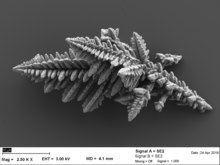Dendrite (crystallography)
As dendrites (from the Greek dendron "tree") is referred to in the metallo and crystallography tree- or bush-like crystal structures .
In the geology they exist for example, as crystallisation of iron - and manganese - oxides on rock surfaces ; these are often confused with fossils from plant remains ( pseudofossils ).
Formation of dendrites

Dendrites arise during the crystallization of a supersaturated gas phase or melt when the crystal structure has preferred growth directions.
One example is the snowflake (see left picture). After a crystallization nucleus has formed, structures grow along the six [100] directions of the hexagonal lattice structure of ice, that is, along the basal planes at an angle of 60 ° to each other. The growth rate along the direction [001] perpendicular to the basal planes is slow. If it were large in comparison, one would not observe flat snowflakes, but elongated snow needles ( polar snow ).
Small snowflakes are built up symmetrically, unlike, for example, the ice structures on a window pane, see picture on the right. Because the crystallization environment is almost identical for all sides of a small crystallization nucleus in the air. The growth of the six processes is almost the same. Disturbances in the macro-environment, for example changes in supersaturation, affect all processes equally. Differences in the microenvironment on a scale of a few millimeters cause the subtle differences between the 6 dendrite trees. The environment varies from germ to germ, which is why no two snowflakes are the same.
In solidifying metal melts, dendrites are formed with a relatively small number of nuclei and a high rate of crystallization paired with a strong crystal growth anisotropy, as can be found, for example, in cast, solidifying steel. Starting from internal or foreign nuclei, individual crystal needles grow in preferred directions, according to the heat dissipation in the melt. After short growth times, further columnar crystals emerge at right angles to the existing transcrystallites in all directions. This leads to a fir tree-like crystallite, which represents the dendrite in the micrograph.
Dendrite growth in electrochemical elements

Dendrites can grow on the electrodes of accumulators through electrochemical processes . If they penetrate the separator between the electrodes, this leads to a short circuit in the cell. This results in complete failure or, in less pronounced cases, accelerated self-discharge of the cell.
Metal trees
Dendrites can not only arise during electrolysis, metallic tree structures can also grow if the metal is deposited by a reducing agent, for example a less noble metal. The dendritic metal trees can arise, for example silver trees from silver salt solutions.
Web links
Individual evidence
- ^ Brockhaus ABC Chemie , VEB FA Brockhaus Verlag Leipzig 1965, p. 274.


